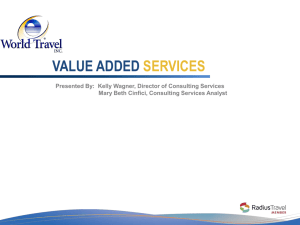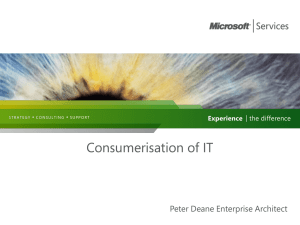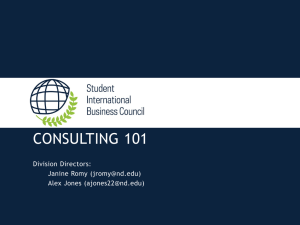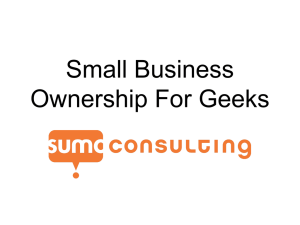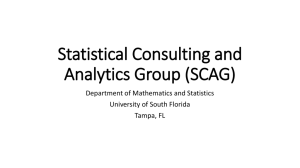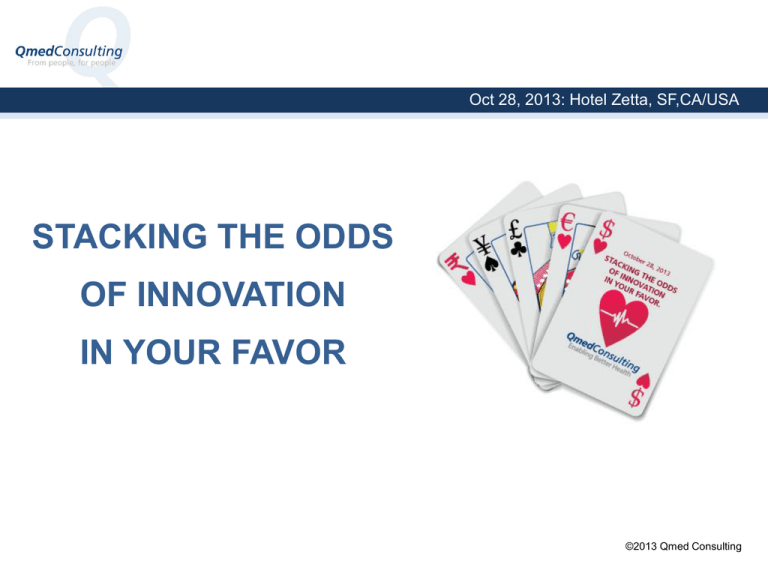
2013
Oct 28, 2013: Hotel Zetta, SF,CA/USA
STACKING THE ODDS
OF INNOVATION
IN YOUR FAVOR
©2013 Qmed Consulting
From Idea To Revenue
1. Innovation Commerce
1. Introductions
1. From Idea to Revenue: antia therapeutics project
1. Big Picture
©2013 Qmed Consulting
Innovation Commerce
Innovation Commerce:
Every new product is as unique as the innovation it
delivers
-
Determines the innovations unique value for
market decision-makers.
-
Provides credibility to innovation and documents
market potential.
-
Defines what clinical and economic evidence is
needed to demonstrate such value.
-
Significantly increases the probability of
calculating realistic sales targets and reaching
them.
-
Leads to faster revenue growth.
©2013 Qmed Consulting
antia therapeutics
antia therapeutics:
-
Privately owned, founded in 2007
-
Device: EasyxTM Liquid Embolic
-
Purpose: provide a liquid embolic system with
clearly identified competitive advantages for
minimally invasive image-guided embolization of
hyper vascular Lesions
-
Status: Pre-Clinical
©2013 Qmed Consulting
Our Expertise
Global Alliance
•
Qmed Consulting has learned that success
comes with working closely with other
organizations.
©2013 Qmed Consulting
Introductions
Global Alliance Team
•
•
•
•
•
•
Helene Quie, Owner Qmed Consulting, Clinical Affairs, EU
Melissa Martinson, President of Technomics Research, Biostatistics
and US Health Economics
Ernesto M. Nogueira, Owner Value Connected, Commercial Healthcare
EU, S. America, Middle East
Naresh Kumar Pagidimarry, Co-founder 8c Healthcare, Bioengineering
CRO, India
Mike Winegar, Owner Winegar Consulting, Regulatory Affairs, Global
Autumn Ediger, Senior Principal Advisor, Qmed Consulting, Clinical
Regulatory Affairs, EU & US
©2013 Qmed Consulting
Qmed Services
We provide full-service medical device CRO services
to people who change healthcare
Clinical
Affairs
Regulatory
Affairs
Quality
Management
Commercial
Healthcare
Concept & Product
Development
EU Authorized
Representative
©2013 Qmed Consulting
Our Expertise
Trusted Subcontractor
•
Qmed Consulting is the Scandinavian
subcontractor to Top 40 medical device
companies and global CROs since its
establishment in 2006.
Trusted Partner to Hospitals and Investigators
•
It is of high importance to Qmed to build
trusted relationships with hospitals. Qmed
employees have daily contact to health care
personnel. We have a working relationship to
more than100 hospitals globally.
©2013 Qmed Consulting
Economic and Statistical Analysis of
Healthcare Technology
©Technomics Research 2013
Introduction to Technomics Research
Technomics Research
is dedicated to the demonstration of the value of
healthcare technologies in support of regulatory
approval, coverage, reimbursement, and rapid
dissemination into the market.
Melissa Martinson, MS PhD President
•
•
•
•
•
MS Statistics / PhD Health Services Research (U of MN)
Adjunct Assoc. Professor, Univ. of Minnesota & St. Cloud State Univ.
Teaches economic modeling
15+ years in major medical device and pharmaceutical firms
10 years consulting to medical products industries and managed care
©2013 Qmed Consulting
Experienced Team at
Technomics Research
Our team:
• PhD economists
• MS statisticians
• data analysts
• student intern (not
pictured)
©2013 Qmed Consulting
A brief introduction
•
Founder has 16 years of experience in Healthcare in sales,
marketing and market access functions
•
KCI
•
Johnson&Johnson
•
GlaxoSmithKline
•
Brazilian Ministry of Health
•
World Health Organization
• MBA from the University of Texas at Austin
• Current Clients
©2013 Qmed Consulting
Solve2Access Holding B.V – Member of the Global Alliance Team
“”We help medical companies demonstrate the
value of their products, develop market access
and increase sales””
Sung koo Tompot
Founder
Stephan Heumann
Founder
Together we have about 20 years working experience in
the healthcare sector. We have an extensive knowledge in
Reimbursement, Clinical and HTA strategies and we can
execute our strategies to the market with our marketing
skills.
We are Healthcare Commercial Experts
©2013 Qmed Consulting
Mike Winegar
©2013 Qmed Consulting
Medical Device Clinical Research
in India
- Role of Bioengineering CRO
Naresh Pagidimarry
Co-founder & CEO
©2013 Qmed Consulting
Overview
• 8C Healthcare is first of its kind Bioengineering
CRO in India exclusively for:
- Medical Device Clinical Development
- Pre-Clinical / Clinical Research Management
• 8C Healthcare is founded by group of
experienced Biomedical Engineers, Clinical
Research and Regulatory professionals trained
and worked in US MedTech Industry.
©2013 Qmed Consulting
Some key factors make a market attractive
• Size and growth rate
• Barriers to entry
• Possibility to generate sales traction
©2013 Qmed Consulting
2013© ValueConnected, All rights reserved
Source: GlobalData, validated with Primary Research
Which will take the company to its commercial goals
Increase
value
Reduce
risk
Accelerate
adoption
©2013 Qmed Consulting
2013© ValueConnected, All rights reserved
Source: GlobalData, validated with Primary Research
European neurology market (embolic systems) in value
CAGR
7.7%
CAGR
8.0%
CAGR
8.5%
©2013 Qmed Consulting
2013© ValueConnected, All rights reserved
Source: GlobalData, validated with Primary Research
European neurology market (embolic systems) in volume
CAGR
8.2%
CAGR
8.4%
CAGR
9.2%
©2013 Qmed Consulting
2013© ValueConnected, All rights reserved
Source: GlobalData, validated with Primary Research
Market sizing: quantitative analysis
©2013 Qmed Consulting
2013© ValueConnected, All rights reserved
Assessing the attractiveness of the largest markets
• National reimbursement
system
• Demands French evidence
data
• Some key decision-makers
with strong influence
• Well-prepared surgeons base
France
NOW
• National reimbursement
system
• Open to international
evidence
• Some key-decision-makers
with strong influence
• Well-prepared surgeons base
Germany
NOW
• Regional reimbursement
systems
• Open to international
evidence
• Fragmented decision-makers
across 21 regions
• Variable levels of surgeons
base
Italy
LATER
©2013 Qmed Consulting
Source: GlobalData, validated with Primary Research
Moving forward – demonstrating the value of Antia
Decisionmakers
Influencers
Value
positioning
Pricing
©2013 Qmed Consulting
2013© ValueConnected, All rights reserved
Source: GlobalData, validated with Primary Research
Michael Winegar
Principal
Winegar Consulting, Inc.
©2013 Qmed Consulting
Intended Use
The Antia Easyx™ Liquid Embolic System is a polymer in
liquid with an intended use for embolization through small
lumen delivery systems (microcatheters, needles). Injected
as a liquid, it subsequently provides a solid cast of the
vessel lumen after precipitation in body tissue, where the
solvent dissipates in the body. Delivery occurs under
controlled flow and allows for occlusion of hypervascular
lesions, such as brain arteriovenous malformations or
dural arteriovenous fistulae.
Winegar Consulting, Inc.
©2013 Qmed Consulting
Predicate Device(s)
EUROPE
Onyx® LES
Indicated for embolization of vascular lesions
Onyx 18 (6% EVOH)
Onyx 20 (6.5% EVOH)
Onyx 34 (8% EVOH)
Onyx® HD-500
Indicated for the treatment of intracranial aneurysms
20% EVOH
US
Onyx LES
Indicated for pre-surgical embolization of brain Arteriovenous Malformations (bAVM)
Onyx 18 (6% EVOH)
Onyx 34 (8% EVOH)
Onyx HD-500
Humanitarian Device, indicated for large, wide-neck aneurysms
20% EVOH
Winegar Consulting, Inc.
©2013 Qmed Consulting
EU
Prospective clinical trial
Retrospective data analysis
Literature review
US
Prospective randomized trial
Winegar Consulting, Inc.
©2013 Qmed Consulting
Country
Cost of Clinical Trials Relative to the
United States
United States
1.00
Australia
0.67
Argentina
0.65
Germany
0.50
Brazil
0.50
China
0.50
Russia
0.41
Poland
0.39
India
0.36
Source: The National Center for Biotechnology Information
Winegar Consulting, Inc.
©2013 Qmed Consulting
# of Trials
2000
1500
1000
# of Trials
500
0
2007
2009
2013
Source: RNCOS India
Winegar Consulting, Inc.
©2013 Qmed Consulting
Pros
Costs
Large population
Motivated researchers
Cons
Data use/credibility
Regulatory barriers, including US export
Relatively new regulations
801(e)(2) export process for Class III devices
Varying standards of care
Winegar Consulting, Inc.
©2013 Qmed Consulting
Protocol Design
Data collection based on study size/goals
Assume device/protocol changes will be made over
time
Country/Site Selection
Consider real costs
Data use and credibility
Regulatory Considerations
Understand site/country timelines and
requirements
Winegar Consulting, Inc.
Engage FDA early
Clinical Research Management
•
•
•
•
First-in-Man Studies
Safety / Pilot Studies
CE Mark / Pivotal Studies
Post-Marketing / Market Access
Studies
Cost
Time
Quality
Antia Easyx™
*FIM / CE Mark Study in India
-
Well experienced Neuro-Radiologists / Interventional Radiologists / Vascular
physicians with high interest towards medical device clinical research. (Published
on the use of Onyx)
-
Clinical practices are on par with US/EU practices & standard of care
-
Easy to train these physicians as they are adaptable and flexible in terms of new
product clinical research. (Establish Product KOL’s within country)
-
Provides access to large patient population for faster enrollment but at the 1/3rd
cost of studies in US/EU (Cost Savings)
-
Offers flexibility in terms of implementation of design changes during the study
(Conduct R&D studies to save time & money with assurance to data quality)
*8C Healthcare – Bioengineering Team
- Support FIM / CE Mark studies (at Indian centers) in terms of technical
aspects, product safety and complete study management.
- Works closely with product R&D team on design changes during the
ongoing study as needed. (can act as local R&D team)
- Ensures Study Data Credibility / Quality and Confidentiality. (addresses
the concerns of data originating from India)
- Compliance to global clinical research standards and practices on par
with conduct of study in US/EU. (addresses the concerns, the way
study is being conducted in India)
- Support with regulatory submissions for ministry of health and Ethics
committee as per local requirements. (advantage of faster regulatory
approvals)
EASYX CHALLENGES IN US MARKET
AND
STUDY DESIGN FOR CE MARK
Antia Easyx Challenges in US Market
1. FDA approval using a minimum of data and time,
especially since European data will likely contain
few AVM resections.
2. Differentiation of EasyX from competitors’
products when providers make a purchase
decision.
CE Mark Study Design
Primary Efficacy:
Percent AVM
Reduction
Primary Safety:
Complete accounting
of safety profile
Statistically speaking,
FIM can roll directly
into CE Mark Study
Selected Clinical Experience for Predicate
Device – Onyx® LES
Jahan R 2001
(CE Mark
study)
SSED
Onyx Arm
2005
Van Rooij
2007
Weber
2007
Saatci
2011
23
46
44
47
350
8/15
20/26
26/18
31/16
206/144
40
40
42
NA
34
14.5 cm3
13.6 cm3
3 .9 cm
NA
NA
% Reduction in
AVM
63%
98%
75%
84%
NA
Death
0%
6%
2.3%
NA
1.4%
Permanent
Morbidity
4%
NA
4.6%
NA
7.1%
# of Patients
Demographics
M/F
Mean Age
Average AVM
achieved ≥
50% reduction
FIM CE Mark Study Design Strategy
# of Patients
Jahan R 2001
(CE Mark
study)
SSED
Onyx Arm
2005
Van Rooij
2007
Weber
2007
Saatci
2011
23
46
44
47
350
~ 80% reduction in AVM
Demographics
M/F
8/15
20/26
40
40
14.5 cm
13.6 cm3
% Reduction in
AVM
63%
98%
Death
0%
6%
Permanent
Morbidity
4%
NA
Mean Age
Targets for Easyx
:
3
Average AVM
26/18
31/16
206/144
~425 - 10% death
NA and
morbidity
3permanent
.9 cm
NA
rate
75%
84%
34
NA
NA
achieved ≥
50% reduction
Estimates
with
2.3%
NA CIs, not1.4%
hypothesis tests
4.6%
NA
7.1%
US FDA Pivotal Trial
• Non-inferiority 1:1 RCT versus Onyx. N in
each arm.
• Efficacy hypothesis:
% AVM reduction is no worse that X% less than Onyx
• Safety hypothesis:
% mortality and major morbidity no worse than X%
higher than Onyx
HEALTH ECONOMICS:
EUROPE (DE, FR) VS USA
Insurance/Payment
Feature of CostEffectiveness
Insurance /
Payment
U.S.
Even under the Affordable Care Act (AHA),
about 5% of the U.S. population will remain
uninsured.
A variety of insurers cover the U.S.
population. About 50% is commercial and
50% is public (government is the payer).
Payment by insurers is determined by billing
codes; technologies that fall under the same
codes are paid the same. (See billing codes
below.)
GERMANY
Only 0,1 to 0,3 % of the German
population are uninsured.
A variety of insurers cover the German
population. About 87,2% of the
population is covered via a basic health
insurance plan, 10,5% are private
insured and 2,3% are covered by other
insurances for example the German
Army or welfare aid.
Acute care is covered for 100% via
DRG’s and special codes for new
technologies and treatment options
Homecare treatment is covered by
different catalogues (doctor, nurses,
therapists) for treatment (Treatment
codes and groups) and materials.
FRANCE
Universal coverage, social model with
contributions based on income levels.
French Government pays for 75% of all
medical costs.
Supplemental coverage comes mostly
from “mutualities” which are not-forprofit private insurers.
Effectiveness
Feature of CostEffectiveness
Effectiveness
U.S.
All insurers state that they do not consider
costs when determining coverage, but only
consider effectiveness.
All insurers act like they do consider costs.
Most insurers are willing to look at costeffectiveness arguments.
Most insurers are not strongly persuaded by
QALYs as the effectiveness measure. They
like natural measures of effectiveness, even
though this limits the comparisons to
treatments with similar effectiveness
measures.
GERMANY
Federal Joint Committee (G-BA) issues
directives for the benefit catalogue of
the statutory health insurance funds
(GKV) for more than 70 million insured
persons and thus specifies which
services in medical care are reimbursed
by the GKV. In addition, the G-BA
specifies measures for quality
assurance for inpatient and outpatient
areas of the health care system.
The insurers follow the quality and
payment guidelines from the GBA, but
there are some options for exceptions
if the Health Technology Assessment
for a new product or treatment option
is not finished.
Because of the economic crisis different
European countries start to analyze the
new and existing products and
treatment options considering the
therapeutic benefit, medical necessity
and economic outcome. The German
GBA is proud to have the toughest HTA
process in Europe.
The physician or nurse can choose the
treatment option if there is no directive
from the insurance company or the
GBA
FRANCE
Very relevant aspect to French
decision-makers, as evidence must be
demonstrated with French data.
This focus reflects the need for
demonstrating the product works
under the French practice, not
necessarily with French patients.
Costs
Feature of CostEffectiveness
Costs
U.S.
Because of the high cost of care in the U.S.,
most insurers prefer cost-saving
technologies over cost-effective
technologies (higher cost but better
outcomes).
The costs of a technology are not limited to
the use of the technology, but can include
downstream healthcare costs.
GERMANY
Because of the cost explosion in the
German healthcare system payers try
to force hospitals to cost savings. This
has a tremendous impact on the
purchasing prices. At the same time
health insurers in cooperation with the
German HTA body GBA try to save costs
by requiring medical and economic
effectiveness.
FRANCE
Depends on the perspective: hospital
budget vs reimbursement.
Hospital budget: extensive focus on
pricing, must justify with strong
evidence.
Reimbursement: cost relevant if
product is more expensive than
alternatives.
Perspective
Feature of CostEffectiveness
Perspective
U.S.
Since healthcare payment is fragmented,
insurers do not care about the societal
perspective. They are about healthcare
costs from their perspective (i.e., payments).
The value argument must be made to the
healthcare stakeholder who bears the cost
of using the technology. This is not always
the insurer, although for new technologies it
usually is.
If there are many similar technologies paid
under the same billing codes, then it is the
provider who cares about the cost of a
particular technology. In this case, make the
value argument to the provider.
GERMANY
Because of the aging population all
insurers, hospitals and German
authorities are interested to find
solutions for society. The reason is that
all healthcare stakeholders receive
taxes, fees or indirect payments from
the German population.
The German government modifies and
readjusts the healthcare sector to
guarantee that every citizen gets the
best treatment considering the
therapeutic benefit, medical necessity
and economic outcome
FRANCE
Healthcare system perspective is the
most relevant.
All reimbursement submissions must
estimate the impact on public
resources with technology adoption.
Payment (Billing Costs)
Feature of CostEffectiveness
Payment
(Billing
Codes)
U.S.
Payment by insurers is determined by billing
codes; technologies that fall under the same
codes are paid the same. (See billing codes
below.)
Some billing codes are controlled by the
insurers and some by the American Medical
Association (AMA).
To get a new CPT code (controlled by AMA),
which allows physicians to be paid for using
a technology, it is often important to have
influential physicians to argue in favor of the
technology.
GERMANY
All DRGs are organized, controlled and
calculated by the InEK institute
(Institute for the Hospital
Remuneration System).
Everyone can apply for new DRG’s (InEK
institute), procedure codes (OPS, via
DIMDI institute), diagnosis codes (ICD,
via DIMDI institute). To be successful it
is better to apply via medical societies
or German KOLs.
Homecare reimbursement is more
stable and does not change every year.
Mostly the score of a service will
change.
FRANCE
Hospitals use the French DRG system
called GHS.
Other providers use a variety of
methods from DRG-like codes to feeper-day for prospective payments.
Level of Evidence for Reimbursement
Feature of CostEffectiveness
Level of
Evidence for
Reimbursem
ent
U.S.
The level of evidence required for coverage
and payment is usually much lower than for
market release (controlled by FDA).
CMS (the Medicare insurer) has some
special conditions for payment for new
technologies that do not require much
evidence up-front.
o
New technology add-on payments
o
Coverage with evidence
development
GERMANY
The level of evidence required for
coverage and payment is higher than
for market release (controlled by GBA).
The GBA normally except only the
highest three evidence levels for acute
and homecare treatment / products.
FRANCE
Very relevant, as French authorities are
very demanding.
However, a strong level of evidence will
not help much if the study has no
French data in it.
Health Economic Data for Cost-Effectiveness
Feature of CostEffectiveness
Health
Economic
Data for
CostEffectiveness
U.S.
It is usually cheaper to collect health
economic data during a clinical trial than to
conduct a separate study to do so.
Many insurers see RCTs as too controlled to
reflect costs under natural settings, and
prefer observational results. If you collect
economic data as part of your clinical trial,
there are ways to address this.
Often FDA requires a post-approval trial;
this can be an excellent venue to collect
health economic data in a more naturalistic
setting.
Because insurers are not terribly interested
in QALYs, it may not be necessary to collect
a lot of quality of life (QoL) data.
Because insurers are interested in their own
costs, in many studies it is only necessary to
collect billing codes and a small amount of
outcomes data.
GERMANY
Every new clinical trial (Acute and
Homecare) must include health
economics data.
Because the GBA is currently examining
existing products regarding economic
and medical effectiveness, it may be
the case that economic effectiveness
data need to be reassessed.
FRANCE
Pharmacists (Hospitals) are excellent
source for cost data considering
economic analysis.
Hospitals place a strong focus on HE
studies and are willing to make their
own analyses in spite of other studies
performed nationally.
Clinical Strategy
Commercial Perspective
Clinical Evidence
Economic Evidence
Technological Challenges
Budget Challenges
#1 challenge for medical products in the market
Justify the price of their
products
©2013 Qmed Consulting
2013© ValueConnected, All rights reserved
There are two possible answers
Lower Price
•Immediate positive impact on
revenues
•Medium and long-term issues
–Pressure for further price cuts
–Weak differentiation point
–Quality of service
•Does not create Value
Demonstrate Value
•Results may not be immediate
•Medium and long-term
opportunities
–Educate and develop market
–Build trust
–Unique market position
•Justifies Price
©2013 Qmed Consulting
2013© ValueConnected, All rights reserved
And what is value?
Perception coming from the market
Benefits to different stakeholders
Comparable to alternatives
OK, and how can I
communicate value?
Measurable/quantifiable
Combines relevant Clinical & Economic aspects
“Our new generator has a new software that
allows for faster system updates.”
This is a FEATURE, not a Benefit
©2013 Qmed Consulting
2013© ValueConnected, All rights reserved
©2013 Qmed Consulting
2013© ValueConnected, All rights reserved
Results today build the pathway for future success
Economic benefits
Clinical benefits
Communication
©2013 Qmed Consulting
2013© ValueConnected, All rights reserved
2013
Big Picture Innovation Commerce
EU = 32 INDIVIDUAL COUNTRIES
REGULATORY STRATEGY = MARKET DATA +
REIMBURSEMENT PLAN
CLINICAL STRATEGY = CLINICAL DATA +
ECONOMIC DATA
IMMEDIATE REVENUE = SELLING TOOLS
BEFORE REIMBURSEMENT
©2013 Qmed Consulting
www.qmed-consulting.com
Qmed Consulting ApS
Ørnevej 2 • 4600 Køge
TEL.: +45 56 64 10 10
Mail: info@qmed-consulting.com





